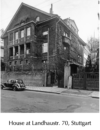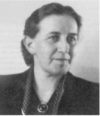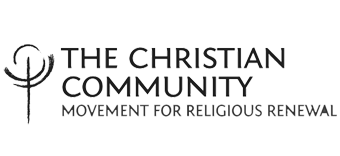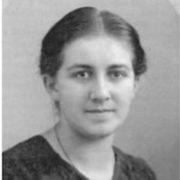Gertrud Spörri – December 8, 1894 – July 16, 1968
–From “Die Gründer Der Christengemeinschaft: Ein Schicksalsnetz” by Rudolf F. Gaedeke, translation by Gail Ritscher
In 1920, a few months after and quite independently of Johannes Werner Klein, Gertrud Spörri’s personal life circumstances led her to ask Rudolf Steiner the question that contributed to the founding of the Christian Community. Although, like Klein, she renounced her vow in 1933, she was nevertheless a key figure during the formation of that first “destiny community,” and she became one of the first female Christian priests.
Gertrud Spörri was born on 8 December 1894 in Bäretswil, Zürich Canton, Switzerland, and grew up with a brother and sister. Her father had inherited a small textile factory from his brother, but when the business fell into serious debt, Spörri had to quit her job and work as her father’s secretary. She had been engaged to be married at the time, but her boyfriend’s father, a wealthy businessman, advised him against making such a financially unfavorable alliance. The engagement was thus broken off, but not before the young man’s sister had introduced the 18-year-old Spörri to anthroposophy (1913).
Spörri worked not only as a secretary, but also as a visiting nurse in neutral Switzerland during and after the First World War. On Reformation Day in 1916, she heard a minister sermonizing “We need a new Reformation!” The fact that he did not expound on the subject and left it as an empty call was deeply disappointing to Spörri, whose spirit had been nourished by anthroposophy for the previous three years.
A year later (1917), after having tried a number of preachers, she was listening to a sermon on Calvin in a small church outside the city when she had an inner vision of someone in vestments, celebrating at the altar and preaching at the pulpit. With a shock, she recognized herself in the vision, and it remained with her from that day forward, piquing her interest in studying theology. First, however, she spent two years at a private school and passed the Swiss higher education entrance exam in the spring of 1920.
Having chosen to study theology at the age of 25, the eldest of 15 students and the only woman, she spoke to Rudolf Steiner at the beginning of her summer semester. The conversation took place in the atelier, at the foot of the Representative of Man, in May 1920. Rudolf Steiner offered to speak to a group of young theologians with whom he felt he could speak more intimately than was currently possible with the doctors. He told Spörri that two theology students from Marburg had been there in the spring, and that if she wanted to make an impact as an anthroposophist and theologian others would need to find their calling as well so that all together they could “seize the pulpits.”
Spörri had actually sat across from the two Marburg students, Martin Borchart, and Johannes Werner Klein, as well as Martin’s wife and Miss Deussen in the cafeteria in Dornach on 8 February. She had listened to their conversation and even joined in a little bit, all completely by chance, as normally she would have returned home that day with the people with whom she was staying.
Although Spörri had been conversing with Rudolf Steiner in Dornach since 1916, it was through this one-hour conversation that she felt inwardly strengthened by the hope that her life could have impact through theology. The question she asked Rudolf Steiner was about the spiritual basis of the sacraments, specifically baptism and communion. In preparing for her higher education certificate, she had been extremely interested in the sciences. It was with real joy that she learned mathematics and geometry, and she later she felt herself on firm ground when studying anthroposophy via Rudolf Steiner’s doctoral thesis “Truth and Science.”
In the autumn of 1920, she met Martin Borchart and Rudolf Meyer at the first University course in Dornach given at the opening of the first Goetheanum. Theological questions were discussed in depth. Johannes Werner Klein was not present. She did not meet him until the spring of 1921, in early April, at the Goetheanum. This was the first opportunity for the two people who had independently approached Rudolf Steiner about a new theology to compare notes. They noticed how Rudolf Steiner had given them both very similar answers, and that he expected a circle of students to ask him for a course. They therefore set about gathering the addresses of those interested, and Klein drafted a first written inquiry and request to Rudolf Steiner.
Spörri had arranged her studies in such a way that she could wrestle with theology Monday through Thursday in Basel and then spend Friday through Sunday on anthroposophy in Dornach. It was at this point that she decided to go to Germany in order to pursue her fundamental question of “who is God, what is God, where is God?” Borchart had recommended she go to Marburg and offered her a room there, but she chose Berlin. Dr. Roman Boos procured a letter of recommendation for the German Consulate from Friedrich Rittelmeyer, although Spörri had never met him. A friend had also provided the address of theological candidate Emil Bock.
After meeting and talking with Johannes Werner Klein in early April 1921 in Dornach, during the second university course, Spörri left for Berlin. She met Bock there, told him in detail everything that had transpired, and showed him Klein’s letter to Rudolf Steiner. Bock rejected the letter, finding it sycophantic, but he was deeply affected by his conversation with Spörri, and so it was now he who immediately set to work. Spörri left for Stuttgart to meet Klein. They also met with Borchart, Ludwig Köhler, Marta Heimeran, Alfred Heidenreich, and Gerhard Klein, but it proved extremely difficult to form a consensus about what the letter should say. In the end, Spörri appealed to Gottfried Husemann, and it was he who found the formulation acceptable to everyone.
After an 8-week break, Rudolf Steiner once again came to Stuttgart from Dornach, and it was here that Spörri and Klein handed Rudolf Steiner the letter. It was also after their conversation with Rudolf Steiner at 3:00 pm on the afternoon of Tuesday, 24 May, that Rudolf Steiner offered the June Course. All this took place in the building that housed the Anthroposophical Community, Landhausstrasse 70, where Rudolf Steiner also lived. Rudolf Steiner: “Free congregations must be established, a ritual is essential, and it must be clear that women are equal partners in the work. All this can be discussed in more detail in three weeks, when they are all together.”
In the middle of the semester, the first 18 interested people met with Rudolf Steiner from Sunday, 12 June to Thursday, 16 June at Landhausstrasse 70 in Stuttgart. They had met one day previously in a classroom of The Independent Waldorf School in order to get acquainted. A few of them attended a Eurythmy matinee at the Cannstatter Wilhelma Theater before the course started.
Rudolf Steiner offered a second course for the autumn, for which he recommended the following: Assemble ten times as many people, write the first brochures, have Dr. Hermann Heisler gather funds, stay in touch with one another, and plan and print the course for the initial and subsequent participants.
Spörri then continued to study in Berlin with Ernst Troeltsch and Adolf von Harnack, and she also became acquainted with Friedrich Rittelmeyer. Starting in August, however, she was very busy collecting money (3,000 Swiss Francs) for the “Autumn Course” in Zürich, Basel, Bern, and Dornach since Rudolf Steiner wanted to hold the course in Dornach and wanted the financial support for it to be in place beforehand.
In the end, more than 100 people came to Dornach to attend the “Autumn Course,” from 26 September to 10 October 1921. Spörri handled all the written communication, room and board, and financial arrangements.
After these full weeks, she gathered with a smaller circle in Dr. Hermann Heisler’s house, the pastor and Anthroposophical speaker in Tübingen, where Rudolf Steiner’s lectures were edited. During the following winter semester, Spörri’s father fell ill in Switzerland and died shortly thereafter. Spörri was obliged to help out at home and take care of the family, which meant she dropped out of the “center” of the initiatives in Berlin and correspondence was left unanswered. When she finally returned to Berlin in February of 1922, she happened to meet Johannes Werner Klein on the train, who was primed to round up those willing to found the new movement.
The expanding circle continued to meet in Berlin (March 1922). They divided up the cities amongst themselves where preparations for establishing congregations were to be made before meeting up again first in Breitbrunn and then in Dornach in September 1922.
Spörri was always actively in the middle of things and was therefore included in the new priest hierarchy—between three Lenkers and three Oberlenkers—with the position of honorary Oberlenker.
On 16 September 1922, in the first Act of Consecration of Man and its embedded Sacrament of Ordination, Spörri was ordained as the very first female priest and celebrated the Act of Consecration for the first time in the White Room of the First Goetheanum.
After having organized all the arrangements for the Autumn Course in 1921, Spörri did the same for the founding gathering in 1922 in Dornach, and then again when all the priests assembled for the Apocalypse Course in September 1924—all the correspondence, gathering of funds in Switzerland, visa processing, lodging, food—everything.
Spörri passed many questions to Rudolf Steiner from the priest circle regarding their work and received many very detailed answers back that were key to establishing the forms of the ritual. It was in the spring of 1924 that she asked him perhaps the most important question, and it is thanks to her that Rudolf Steiner held the “pastoral medicine” course within the Medical Section of the Independent University for Spiritual Science at the Goetheanum in September 1924, in Dornach. This course represents the important beginning of collaboration across multiple professions working out of anthroposophy.
Along with Friedrich Rittelmeyer, Emil Bock, and Hermann Beckh, Spörri founded and expanded the Stuttgart congregation, and it was from Stuttgart that she worked for the priest circle in carrying out the office assigned to her. Later, she also worked for the congregations in St. Gallen and Munich. In 1931, she followed through on the suggestion that Rudolf Steiner himself had made to her by writing all her experiences down in the book “Women at the Altar.” Later, once she was no longer a priest, she published the works “The Divine Purpose of Human Beings” (1948) and “Ancient Revelations of Love in Humanity’s Becoming” (1965).
The great tragedy in Gertrud Spörri’s life was that, after having worked so joyfully on behalf of others, she left the priest circle.
On the surface, it is quite simple to explain what happened. At least one of the two Weidelener brothers pursued and achieved the priesthood harboring an inner lie. He then broke the one fundamental law that all priests of the Christian Community vow to uphold: He arbitrarily altered the forms of the ritual, out of his own self-proclaimed higher insight, and Spörri fell in with this act of hubris. In so doing, she placed herself outside the community under oath, and, on 6 March 1933, she announced her withdrawal.
It is extraordinary that it should be those two representatives of modern confessional theology who had asked Rudolf Steiner—the bearer of the mystery wisdom revealed in anthroposophy—about the renewal of the church and of the sacraments, were also the ones who could not remain steadfast in putting his far-reaching answers into practice: Johannes Werner Klein out of an inner weakness that he sought to strengthen through someone he called “Petra,” and Gertrud Spörri by overestimating her own personal stature in the case of Weidelener.
The year 1933, a year of destiny, was thus also one of deep tragedy for the Christian Community. A common perception then was that one of the oberlenker offices had been weakened first by Christian Geyer’s 1922 withdrawal from active participation in the founding, then by Johannes Werner Klein’s assumption of the office in Geyer’s place, and finally by Spörri’s replacement of Klein in 1929.
Spörri worked in other jobs in Germany until 1939. Then she returned to her homeland of Switzerland, where she was active for decades in the social sphere: first, during World War II, in the International Committee of the Red Cross in Geneva; later, in a sanitorium for tuberculosis.
In the fifties, she once said to Kurt von Wistinghausen, “I don’t need anthroposophy,” so far had she extracted herself inwardly. When she died from a thrombosis after a hip operation on 16 July 16 1968, in Ruti, the cremation celebration of the first female Christian priest took place without a ritual, with just music and readings. The event was accompanied by a mighty storm with thunder and lightning.
From the biography on „Kultur-Impuls“ by the same author:
The tragedy of her life was that she broke her vow not to change the forms of the ritual. Frederick Rittelmeyer was compelled to give her a leave of absence and relieve her of her duties, and she resigned from the priest circle on 6 March 1933.
She continued with her life’s mission of always providing help to others, first in various social activities in Germany, then in Switzerland for the International Red Cross and in a tuberculosis sanatorium. After a hip operation, she died of a thrombosis near her birthplace.
-Rudolf F. Gädeke
MEMORANDUM
Since the spring of 1921, everything I have done came from my resolve to give my all to the Movement, which was just beginning then. At this point, my only way to express this resolve is to say that I will redouble my efforts within the Movement for Religious Renewal. In addition, I will stand ready to work at any time on behalf of or to establish a congregation, should a concrete task come my way, and I would naturally put all other desires on hold to do so.
It is self-evident that a fundamental, quite extensive training will be necessary to prepare for this work, with the goal of reaching consensus on all questions pertaining to congregational and organizational tasks. Even more important will be both our own and the group’s initial and continuing education, as this will help us penetrate everything related to the ritual more clearly. In this regard, we will need Dr. Steiner’s advice and assistance most particularly. How close we are to celebrating the ritual will need to be decided during the discussions at the University Week in Berlin.
Gertrud Spörri
March 2nd, 1922
A Letter from Gertrud Spörri
Stuttgart, Urachstr. 41
June 4th, 1923
My dear Miss Sterkel,
Mr. Bock received your letter shortly before departing and sends his thanks. He gave it to me. Perhaps you could drop by and see me this week. I am always home between 5 and 7pm, and this week, other than Thursday and Friday, I will also be home later in the evening, if that works better for you. I would love to have some quiet time with you to discuss the many questions with which we are both wrestling now.
Is it true that your father is seriously ill and is in the Olga Hospital? If so, please let me know and I would be happy to come see you, if you cannot get away. Rest assured; I completely share your concern for him.
I hope I will have the chance to get to know you personally soon.
Until then, with warmth,
Gertrud Spörri.
I believe you are aware that I work with Dr. Rittelmeyer and Mr. Bock at the Christian Community.


Leave a Reply
Want to join the discussion?Feel free to contribute!